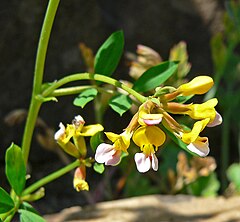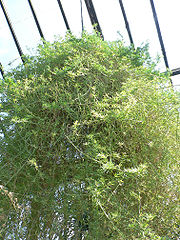Lotus (genus)
| Lotus subsp. var. | ||||||||||||||||||||||||||||||||||||||||||||||||||||||||
|---|---|---|---|---|---|---|---|---|---|---|---|---|---|---|---|---|---|---|---|---|---|---|---|---|---|---|---|---|---|---|---|---|---|---|---|---|---|---|---|---|---|---|---|---|---|---|---|---|---|---|---|---|---|---|---|---|

|
|
| ||||||||||||||||||||||||||||||||||||||||||||||||||||||
| ||||||||||||||||||||||||||||||||||||||||||||||||||||||||
Some species, such as L. berthelotii from the Canary Islands, are grown as ornamental plants. L. corniculatus is an invasive species in some regions of North America and Australia.
| Standard Cyclopedia of Horticulture |
|---|
|
Lotus (an old Greek name). Leguminosae. Herbs and subshrubs, grown for the yellow, purple, rose- colored or white flowers. Plants glabrous, silky or hirsute: lvs. with 3-5 lfts. crowded at the apex of the petiole and commonly 2 joined to the st. and resembling stipules: fls. mostly pea- shaped, often in axillary few-fld. umbels, rarely solitary; standard broad, contracted at base; wings obovate; keel incurved or inflexed, beaked; calyx-lobes longer than the tube; stamens 9 and 1, connate but free from the petals: pod oblong or linear.—Species 80-100, largely in the Medit. region, but also in S. Afr., Temp. Asia and Austral. By some botanists, the genus Hosackia (which see) has been united with Lotus, but it differs in having usually morel lfts., short calyx-teeth, obtuse keel. One lotus (L. corniculatus) has become established in N. Amer. Lotus nigricans of cult, is Kennedya, nigricans. Lotus meant several things to the ancients: (1) the Greek lotus, a leguminous plant on which horses fed. This was probably what we call to-day Lotus cor- niculalus, the common bird's-foot trefoil of temperate regions. (2) The Cyrenean lotus, an African shrub, the fruit of which was eaten by certain North African tribes who were called lotus-eaters. The fruit was said to be honey-sweet, the size of an olive and in taste like a date. This was probably Zizyphus Lotus, a prickly shrub whose fruit is, however, considered inferior to that of the common jujube, Zizyphus saliva. Other conjectures have been: Celtis australis, a tree which has a small, sweet berry; Nitraria tridentata, a thorny desert shrub whose succulent fruit has a stimulating quality, and Rhanmus Lotus, another North African plant. European lotus is a name for Diospyros Lotus, a kind of date plum which is cultivated in southern Europe, but the fruit is hardly edible. (3) The Egyptian lotus or sacred lily of the Nile. This is Nymphsea Lotus, which, like the Hindu lotus, has rose-colored as well as white flowers. American cultivators at the present time almost universally consider that the true Egyptian lotus is Nelumbium speciosum, now called Nelumbo, but Nelumbium speciosum is not a native of Egypt. (4) The Hindu and Chinese lotus, also called the sacred or Pythagorean bean. This is Nelumbo indica, better known us Nelumbium speciosum. The name lotus was doubtless used for other water-lilies, particularly the blue-flowered Nymphsea caerulea.
|
Cultivation
Propagation
Pests and diseases
Species
Selected species==
- Lotus aboriginus – Rosy Bird's-foot Trefoil
- Lotus aduncus
- Lotus alamosanus – Sonora Bird's-foot Trefoil
- Lotus alpinus
- Lotus angustissimus – Slender Bird's-foot Trefoil
- Lotus argophyllus – Silver Bird's-foot Trefoil
- Lotus argyraeus – Canyon Bird's-foot Trefoil
- Lotus benthamii – Bentham's Deervetch
- Lotus berthelotii – Canary Islands Trefoil
- Lotus cedrosensis
- Lotus corniculatus – Common Bird's-foot Trefoil, Bird's-foot Deervetch
- Lotus crassifolius – Big Deervetch, Broad-leaved Bird's-foot Trefoil
- Lotus creticus
- Lotus dendroideus – Island Deervetch
- Lotus denticulatus – Riverbar Bird's-foot Trefoil, Meadow Bird's-foot Trefoil
- Lotus formosissimus – Seaside Bird's-foot Trefoil
- Lotus glaber – Narrow-leaved Bird's-foot Trefoil, Slender Trefoil, Creeping Trefoil, Prostrate Trefoil; formerly L. tenuis
- Lotus grandiflorus – Chaparral Bird's-foot Trefoil
- Lotus greenei – Greene's Bird's-foot Trefoil
- Lotus hamatus – San Diego Bird's-foot Trefoil
- Lotus haydonii – Rock Bird's-foot Trefoil
- Lotus heermannii – Heermann's Bird's-foot Trefoil
- Lotus humistratus – Foothill Deervetch
- Lotus incanus – Woolly Bird's-foot Trefoil
- Lotus intricatus – Arid Bird's-foot Trefoil
- Lotus jacobaeus
- Lotus japonicus
- Lotus junceus – Rush Deervetch
- Lotus maculatus
- Lotus maritimus
- Lotus mearnsii – Mearns' Bird's-foot Trefoil
- Lotus micranthus – Desert Deervetch
- Lotus mollis
- Lotus nevadensis – Nevada Bird's-foot Trefoil
- Lotus nuttallianus – Wire Bird's-foot Trefoil
- Lotus oblongifolius – Streambank Bird's-foot Trefoil
- Lotus ononopsis
- Lotus ornithopoides
- Lotus palustris
- Lotus parviflorus – Smallflower Bird's-foot Trefoil, Smallflower Trefoil
- Lotus pinnatus – Meadow Bird's-foot Trefoil, Bog Bird's-foot Trefoil
- Lotus plebeius – New Mexico Bird's-foot Trefoil
- Lotus procumbens – Silky Deerweed
- Lotus purshianus – Spanish Clover
- Lotus rigidus – Desert Rock Pea, Shrubby Deervetch
- Lotus rubriflorus – Redflower Bird's-foot Trefoil
- Lotus salsuginosus – Coastal Bird's-foot Trefoil
- Lotus scoparius – Common Deerweed, Common Deervetch, California Broom, Western Bird's-foot Trefoil
- Lotus sessilifolius
- Lotus stipularis – Balsam Bird's-foot Trefoil
- Lotus strigosus – Strigose Bird's-foot Trefoil
- Lotus subbiflorus – Hairy Bird's-foot Trefoil
- Lotus tetragonolobus – Winged Bird's-foot Trefoil
- Lotus unifoliolatus – American Bird's-foot Trefoil
- Lotus pedunculatus – Greater Bird's-foot Trefoil, Marsh Bird's-foot Trefoil, Large Bird's-foot Trefoil, Big Trefoil; formerly L. uliginosus.
- Lotus utahensis – Utah Bird's-foot Trefoil
- Lotus wrangelianus – Chilean Bird's-foot Trefoil
- Lotus wrightii – Wright's Deervetch
- Lotus yollabolliensis – Yolla Bolly Bird's-foot Trefoil
Gallery
If you have a photo of this plant, please upload it! Plus, there may be other photos available for you to add.
References
- Standard Cyclopedia of Horticulture, by L. H. Bailey, MacMillan Co., 1963
External links
- w:Lotus (genus). Some of the material on this page may be from Wikipedia, under the Creative Commons license.
- Lotus (genus) QR Code (Size 50, 100, 200, 500)





